Parasites That Infect Humans
We often don’t think parasites can be a big risk to ourselves and indeed it’s not appealing to think about, especially when you are eating! However, parasitic infections are very common and most of the time, these infections go unnoticed. A high percentage of people throughout the world live with a worm or other parasite. As close as we may be with these organisms, they are not symbiotic – they can cause awful diseases as well as nightmares!
Parasitic infections must always be taken seriously.
- Over one billion people worldwide are infected with parasites
- Most infected people do not know they have parasites
- Some of these parasites can grow to 8 feet long inside your gut
- Some of these parasites can live for 30 years in your gut
- Some worms can invade our central nervous system (brain and spinal cord)
- These parasites can steal your nutrients and make you tired
The most important thing to have is an awareness of these diseases, so you can prevent them. Meticulous hand washing with soapy water (and ideally wearing gloves when preparing food), thorough washing of fruits and vegetables, and proper cooking of meats are vital strategies to lower your risk of catching these spooky parasites.
Let’s look at these parasites up close
Protozoa
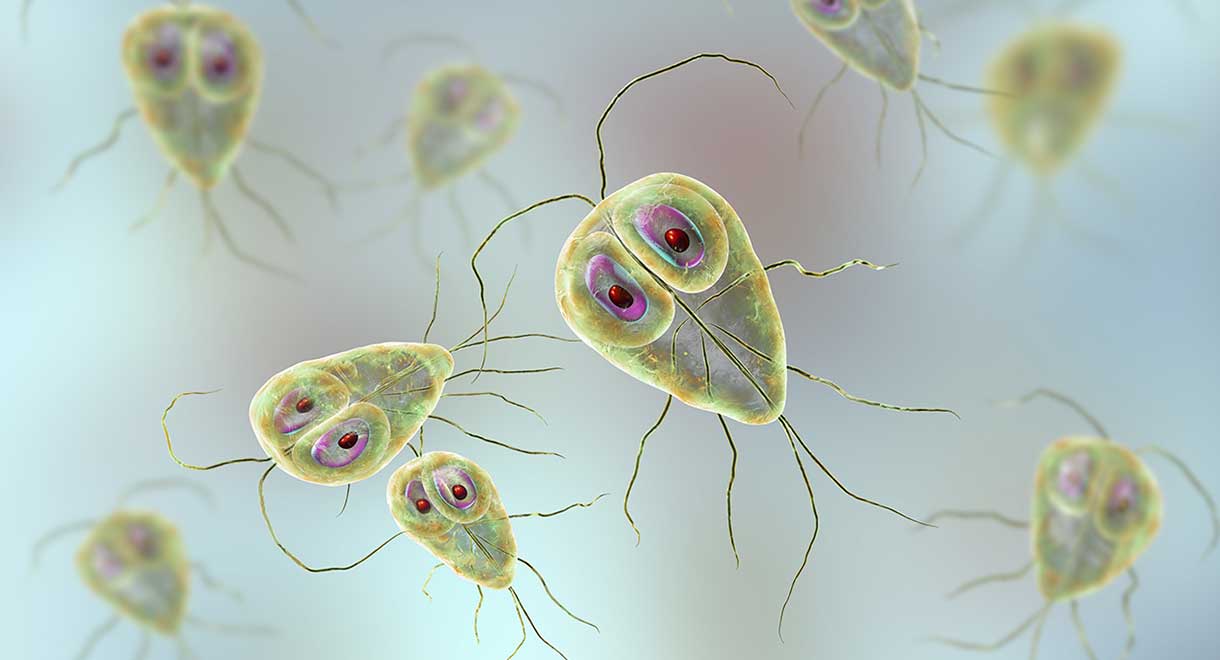
Protozoa are microscopic, single-celled organisms which reproduce very rapidly in the intestines. They can spread to other organs such as the liver, pancreas, lungs and heart. Protozoa have an indefinite lifespan.
Examples of protozoa include:
- Giardia lamblia is a protozoon which is transmitted through water, food and contact with feces and infects the small intestines. Giardia may not cause any symptoms but can also cause diarrhea, bad-smelling stools, nausea, abdominal cramps, bloating, gas and weight loss.
- Cryptosporidium parvum is transmitted by contact with infected human feces or water. It may not cause any symptoms or can produce watery diarrhea, nausea, cramps and fever.
- Cyclospora species is common in travellers and is spread by contaminated water, feces, fruits and basil. Symptoms are intermittent and can include diarrhea and weight loss, etc.
- Entamoeba histolytica is spread through water, food, flies and cockroaches. It may take up to three months after infection before symptoms appear, and in many cases infected carriers have no symptoms. It can spread through the digestive tract and travel to other organs, causing stomach pain, diarrhea and low grade fever.
- Toxoplasma gondii is an infection that is usually transmitted from cats. A less common source of transmission of toxoplasma is undercooked meat. Symptoms include flu-like symptoms such as fever, headache, swollen lymph nodes (glands), and lethargy.
- Trichomonas vaginalis is transmitted through sexual contact or from contaminated toilet seats, towels, spas or bathwater. There are often no symptoms; however, it can cause vaginal discharge and odor, painful urination, enlargement of the prostate gland, and urinary tract inflammation.
Roundworms and hookworms
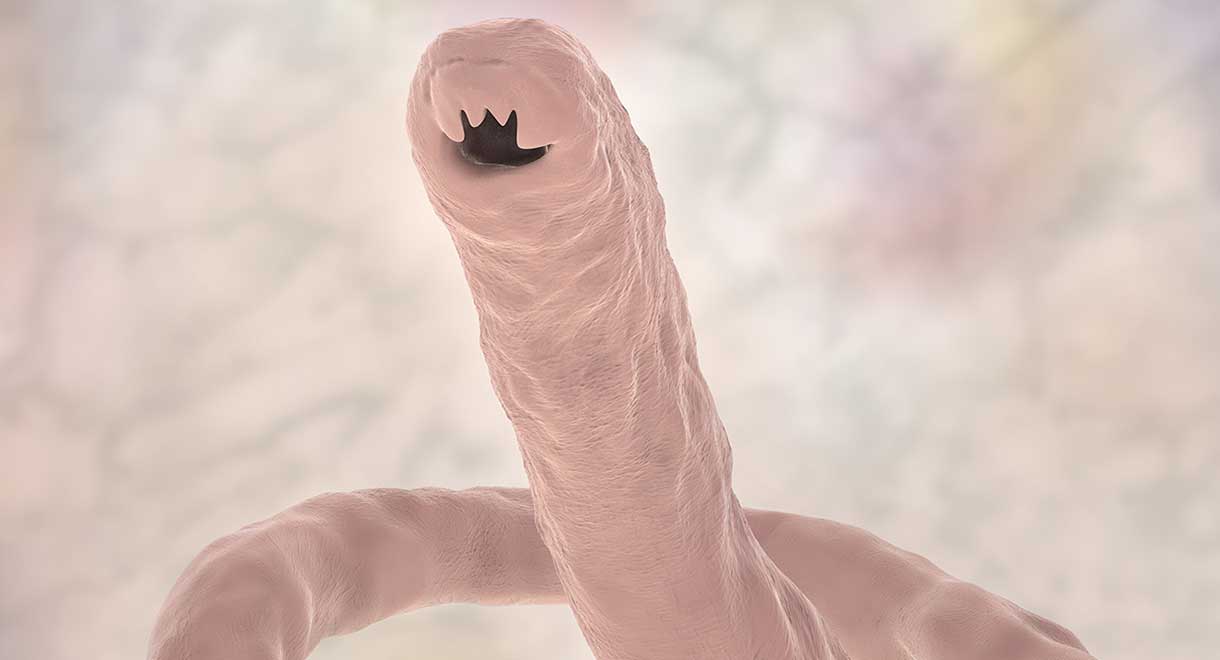
These are unsegmented worms which produce eggs that need incubation in soil or in another host before becoming potentially infective to humans.
- Roundworm (ascaris lumbricoides) infects over one billion people in the world and often produces no symptoms or signs. The source of infection is contamination of soil and vegetables with feces. Adult roundworms reside in the small intestines and can exit through the mouth or nose of the infected person. Occasionally, they can cause obstruction of the pancreatic or bile duct, appendix, or small intestines with severe symptoms. Infection may cause a cough, fever and sleep disturbances.
- Hookworms (Necator americanus) are transmitted through unbroken skin by walking barefoot. Hookworms travel into blood and through the lungs and intestines. Hookworm infection usually does not cause any symptoms, although there may be an allergy-like itchy rash or itching at the area of skin penetration. The worms attach to and suck the blood from the lining of the small intestines, causing digestive problems, anemia and fatigue.
- Pinworm (Enterobius vermicularis) infection is common and is transmitted through contaminated food and water. The worms live in the lower intestines near the rectum and travel at night outside to the skin around the anus. From there it can be transmitted through person-to-person contact. It may not cause any symptoms; however, itching at night around the anus is common. One method of diagnosis is to apply sticky tape to the anal area at night. When the tape is removed, adult worms may be seen with the unaided eye. Do this test 5 to 7 times to rule out infection.
- Whipworm (Trichuris trichiura) is a parasite of the large intestine that rarely produces any symptoms. It is transmitted by ingestion of the eggs which reside in soil or on vegetables. Heavy infection can cause diarrhea, abdominal pain, rectal prolapse, and stunted growth.
- Trichinella (Trichinella spiralis) infection can occur from eating undercooked pork. Worms travel from the intestines into the muscles of the upper arms, chest, diaphragm and jaws. Symptoms can include diarrhea, nausea, severe muscle pain, facial swelling, difficulty breathing, painful chewing, and enlarged lymph nodes (glands).
Tapeworms
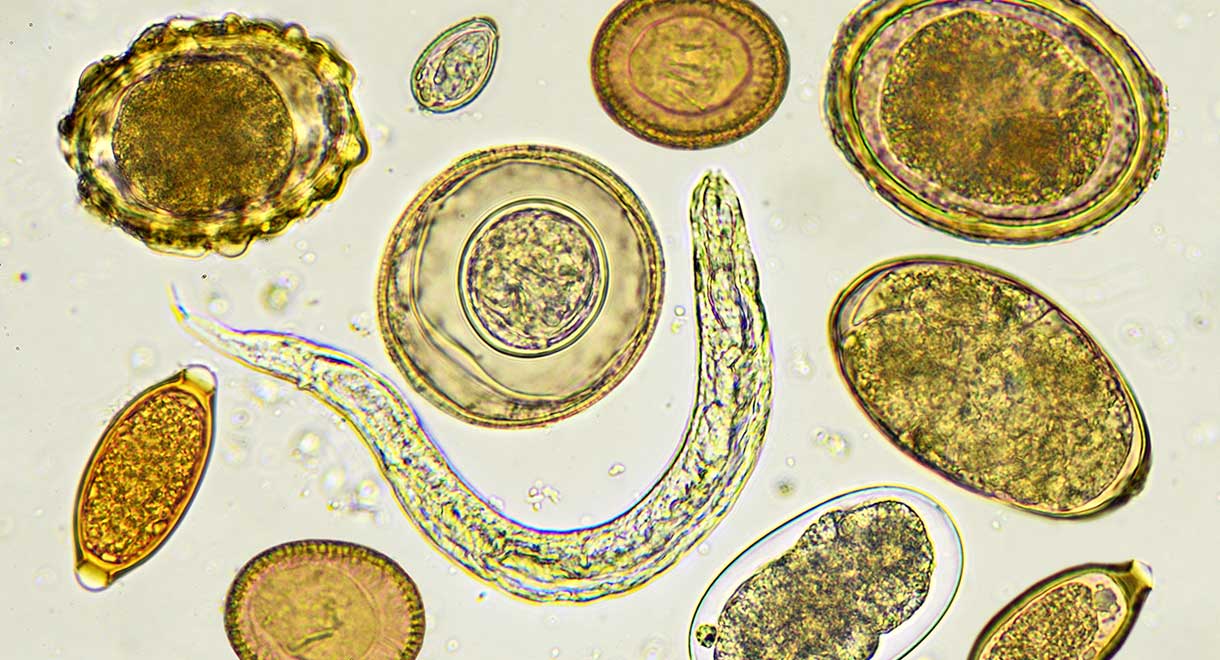
Tapeworms are flat and segmented and shaped like ribbons, and can grow to very large lengths. Tapeworm larvae can be found in undercooked meat or fish. From the larvae, the worms grow and develop and attach to the small intestine. The tapeworm lives in the small intestine by absorbing nutrients from ingested foods. Tapeworm infection often produces no symptoms, but nutritional deficiencies may arise, as it steals nutrients from the host.
Tapeworms can steal our nutrients, block our intestines, and take up space in our organs. A tapeworm cyst can lodge in the brain, eye, liver, and other parts of the body.
- Pork tapeworm (Taenia solium) infection occurs after eating undercooked pork, smoked ham, or sausages containing larvae. Adult worms attach to the intestines and may cause symptoms similar to infection with beef tapeworm. Larvae can travel to areas under the skin, the muscles, the brain, spinal cord and the eyes, where they eventually form cysts. These cysts cause an inflammatory response, which may take 4 or 5 years to occur. This can result in blindness, seizures, neurological deficits, and hydrocephalus (swelling of the head).
- Beef tapeworm (Taenia saginata) infection occurs after eating undercooked beef containing the larvae. It can live in the intestines for up to 25 years and grow to a huge length of up to eight feet. It often causes no symptoms but occasionally presents as abdominal pain, loss of appetite, weight loss and diarrhea. Segments of the worm can crawl out of the anus.
- Fish tapeworm (Diphyllobothrium latum) infection occurs from consuming freshwater fish containing larvae. Fish tapeworm can grow to 15 meters in length. Symptoms can include loss of appetite, indigestion, weight loss and diarrhea. Deficiencies of vitamin B12 and iron can arise. Neurological symptoms such as muscle twitches may occur.
- Clonorchis sinensis is another worm transmitted by eating raw fish. These worms live in the gallbladder and can cause stones in the bile ducts and gallbladder.
Flukes
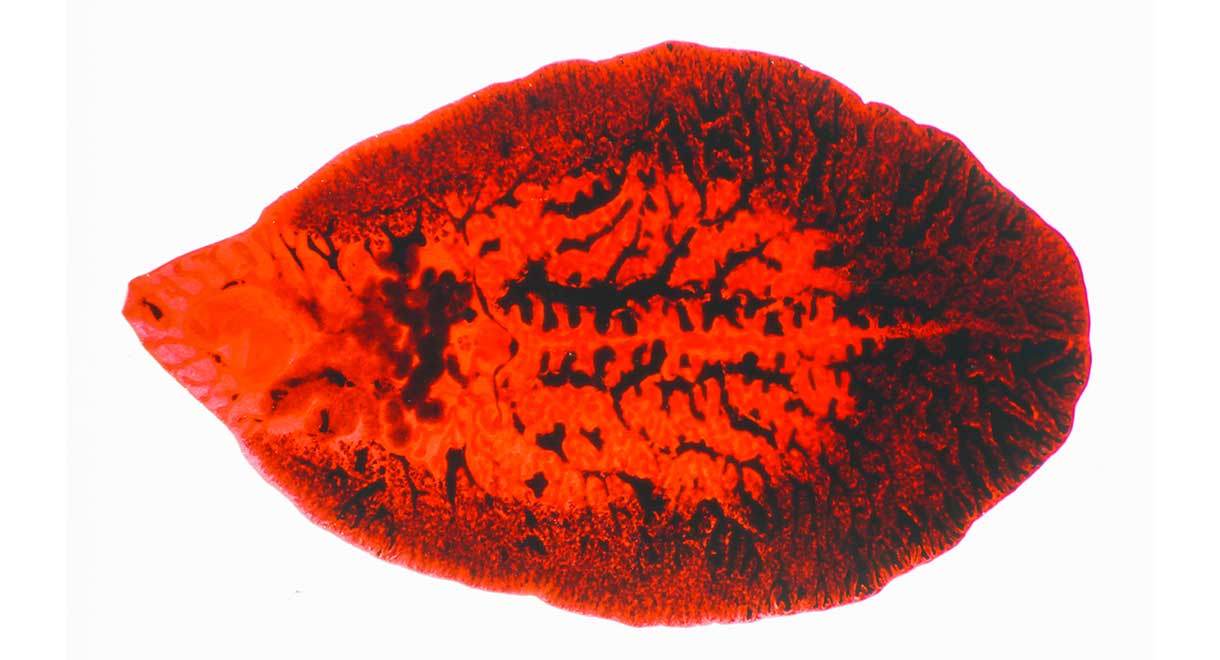
Trematodes, or flukes, have an enormous impact on the health of humans and infect over 200 million people worldwide. Flukes are flatworms and are leaf-shaped and attach to the host using abdominal suckers. It usually begins its life cycle in snails as larvae that then infect fish, vegetation, or humans. Flatworms can travel to lungs, intestines, bile ducts, heart, brain, and the liver.
- Intestinal fluke (Fasciolopsis buski) – these worms live in the small intestines and can cause intestinal ulcers and allergic reactions. Symptoms include vomiting, diarrhea, and stomach pain. Infection with intestinal fluke arises from eating infected water vegetables, such as water chestnuts, bamboo shoots and watercress.
- Oriental lung fluke (Paragonimus westermani) is found most commonly in Asian countries. These worms can penetrate the intestines and travel to the brain or lungs. Symptoms of infection include coughing fits and blood-stained sputum. Sources of these worms include undercooked crabs and crayfish.
- Sheep liver fluke (Fasciola hepatica) is most commonly transmitted from fresh watercress. The worm attaches to the gallbladder and bile ducts, causing inflammation and local trauma. Symptoms include jaundice, fever, coughing, vomiting, and abdominal pain. Cancer of the bile ducts may occur.
- Paragonimus is a parasitic fluke (flatworm) and after being eaten it can travel to other parts of the body and cause low fever, fatigue, cough, abdominal pain and muscle pain. The parasite can travel to other organs especially the lungs, but also rarely the liver or heart. In the lungs, the parasite can cause cough with blood stained mucus. It can rarely travel to the central nervous system. It can be fatal in rare cases. Over 20 million people are believed to be infected worldwide. Most cases are found in Asia, but it can also be found in Africa and the Americas. Cases sometimes occur in the United States, particularly in the Midwest and southern states. These are due to Paragonimus kellicotti from eating raw or undercooked fresh water crab or crayfish. It can be diagnosed by finding eggs in sputum samples (or in stool samples if the eggs are coughed up and swallowed).
- Schistosomes are water-borne flatworms or blood flukes that enter the human body through the skin. Schistosomiasis is a disease caused by the larvae of these flatworms. The larvae, which normally mature in snails that also live in those lakes, enter through your skin as you swim or bathe in a fresh water lake.
Schistosomiasis is the second most prevalent tropical disease after malaria and is a leading cause of disease in many parts of the world. It is not uncommon in Australia because of the many travellers who visit endemic areas and swim in freshwater lakes. It is not found in the United States, but it’s a very common disease worldwide, infecting some 240 million people every year. It is found in 70 countries and is also called bilharzia or bilharziasis. The disease is most commonly found in Africa, Asia, and South America.
In tropical countries, schistosomiasis is second only to malaria among parasitic diseases with the greatest economic impact. These worms require more than just humans for their life cycle; they require fresh water lakes and ponds with snails. The schistosome eggs are contained in human stool or urine, and are deposited in lakes where people do not have sufficient sanitation. These eggs hatch, and then in the next stage of development they live within the snails in the lake. Larvae later emerge from the snails and spread into the water, where they will find a human. The larvae penetrate the person’s skin, enter into their bloodstream, and then pass through the lungs and other parts of the body until they land where they lay eggs; the cycle then begins again. Some people feel itchy where the larvae enter the skin. Symptoms can include an itchy rash, fevers, a dry cough, muscle pain, headaches and blood in the urine. The immature worms can get lost in the body, getting trapped in the lungs or brain and can cause paralysis, speech problems, and seizures. If the infection travels into the veins around the liver, the person may have an increased risk of cirrhosis and other liver problems, including liver and bowel cancer.
The drug praziquantel is an effective treatment; however, the disease is often found late, when it already has damaged the liver or other organs, and that damage can’t be undone. Schistosomiasis is a disease of poverty and poor waste sanitation.
Orthodox medical treatment
Drugs to treat infections with protozoa
- Daraprim (pyrimethamine)
- Diloxanide
- Fasigyn (tinidazole)
- Flagyl tablets (metronidazole)
- Mepacrine
- Pentacarinat injection
- Pentostam (sodium stibogluconate)
- Wellvone (atovaquone)
- Nitazoxanide
- Furazolidone and quinacrine are effective but are now rarely used because of potential toxic side effects. Alternatives to these medications include paromomycin, quinacrine, and furazolidone.
Drugs to treat infections with roundworms and hookworms
Drugs that rid the body of parasitic worms are known as anti-helminthic drugs. Examples include albendazole and mebendazole. Infections are generally treated for 1-3 days. These drugs are effective and generally have few side effects.
Mebendazole is used to treat threadworms, roundworm, whipworm and hookworm infections.
Drugs used to treat infections with tapeworms
The most commonly used drugs are Praziquantel (Biltricide), Albendazole (Albenza), and Nitazoxanide (Alinia).
Drugs used to treat infections with flukes
Fluke infections are treated with the drugs praziquantel or triclabendazole. If the brain is infected, corticosteroids may also be given.
Recommended books
Natural remedies against intestinal parasites
There are herbal extracts and oils which have natural anti-microbial properties, and can be used for several weeks to several months to reduce the risk of catching intestinal parasites and to prevent them from recurring. These natural remedies can also be used after a course of drugs is taken. Many people have parasites and they are not always easy to detect in tests of the feces. Using these natural remedies may resolve your symptoms.
- Intestinal Para Clean capsules
Intestinal Para Clean capsules contain a combination of traditionally used anti-microbial substances to fight parasites. Each capsule contains:
– Wormwood flower and leaf (Artemisia absinthium)
– Black Walnut Green Hull (Juglans nigra)
– Cloves (Syzygium aromaticum)
– Garlic (Allium sativum)
– Butternut root bark (Juglans cinereal)
– Buckthorn bark (Rhamnus frangula)
– Pau D’Arco (Tabebuia heptaphylla) - BactoClear
BactoClear capsules act as a natural anti-microbial for the gut and can reduce parasites in the small and large bowel. Bactoclear is a specially manufactured enteric coated capsule, which means its active ingredients are protected from stomach acid and are released into the small intestines. Each capsule contains:
– Phellodendron amurense (Phellodendron)
– Essential oils of: Origanum vulgare (Oregano), Thymus vulgaris (Thyme), Syzygium aromaticum (Clove bud) - Raw papaya
In a glass of warm coconut milk, add a tbsp of raw papaya and ½ teaspoon of local honey and mix. Drink it daily for 2 weeks, ½ an hour before food. - Turmeric
Turmeric is antiseptic and anti-microbial and helps in eliminating all kinds of intestinal worms. Take a glass of coconut milk or buttermilk, and add 1 to 2 teaspoons of turmeric powder and mix well. Drink it daily to reduce parasites from the intestines. - Pumpkin seeds
Pumpkin seeds contain a substance called cucurbitacin that has anti-parasitic properties. Mix together a tbsp of roasted pumpkin seeds with half a cup each of water and coconut milk. Drink this mixture each morning half an hour before breakfast for 1 to 2 weeks. - Neem leaves
Grind a handful of neem leaves to form a fine paste. Consume half a tsp of this paste with a glass of water every morning half an hour before breakfast. Do it for 7 days to reduce parasites from the intestines. - Garlic
Garlic has anti-bacterial properties that help get rid of worms and bacteria from the stomach. Chew raw garlic or drink garlic tea daily on an empty stomach for about a week. - Coconut
Coconut can be used to treat intestinal worms and fungi. Eat one tablespoon of crushed raw coconut flesh plus one tablespoon of coconut oil in your breakfast. After 3 hours, drink one glass of warm coconut milk mixed with 2 tablespoons of castor oil. Drink this for 7 days straight to get rid of intestinal worms. Always ensure the castor oil is labelled as edible. - Cloves
Cloves have anti-parasitic effects that destroy intestinal worms and their eggs. Boil two to three cloves with a cup of water in a saucepan. Simmer for 5 minutes and strain. Drink this solution 4 to 5 times daily for a week.
Tests to see if you have parasites
Your doctor can order a stool ova and parasites test to determine if there are parasites and/or their eggs in your stool (feces). It is an easy and inexpensive lab test and is commonly requested. Your doctor will probably ask you to collect a sample of your stool at home and drop it to the laboratory for testing. The laboratory will perform a microscopic examination of your stool sample. A wet mount preparation is examined for the presence of eggs. It is recommended that three or more stool samples are collected on separate days and each sample needs to be examined. The laboratory may request you to put your stool specimens into special containers with preservative fluid. Specimens not collected in a preservative fluid may need to be refrigerated, but not frozen, until delivered to the lab, so make sure you get exact instructions. Your doctor may request that the laboratory uses specific stains or that special tests be performed to look for parasites not routinely screened for.
Some parasitic infections can be detected by testing blood, but there is no blood test that can check for all parasitic infections. A serology test is used to check for antibodies or for parasite antigens produced when the body is infected with a parasite and the immune system is trying to fight it.
An excellent resource that covers all the parasites that infect mankind can be found at www.cdc.gov/dpdx/az.html
The above statements have not been evaluated by the FDA and are not intended to diagnose, treat or cure any disease.

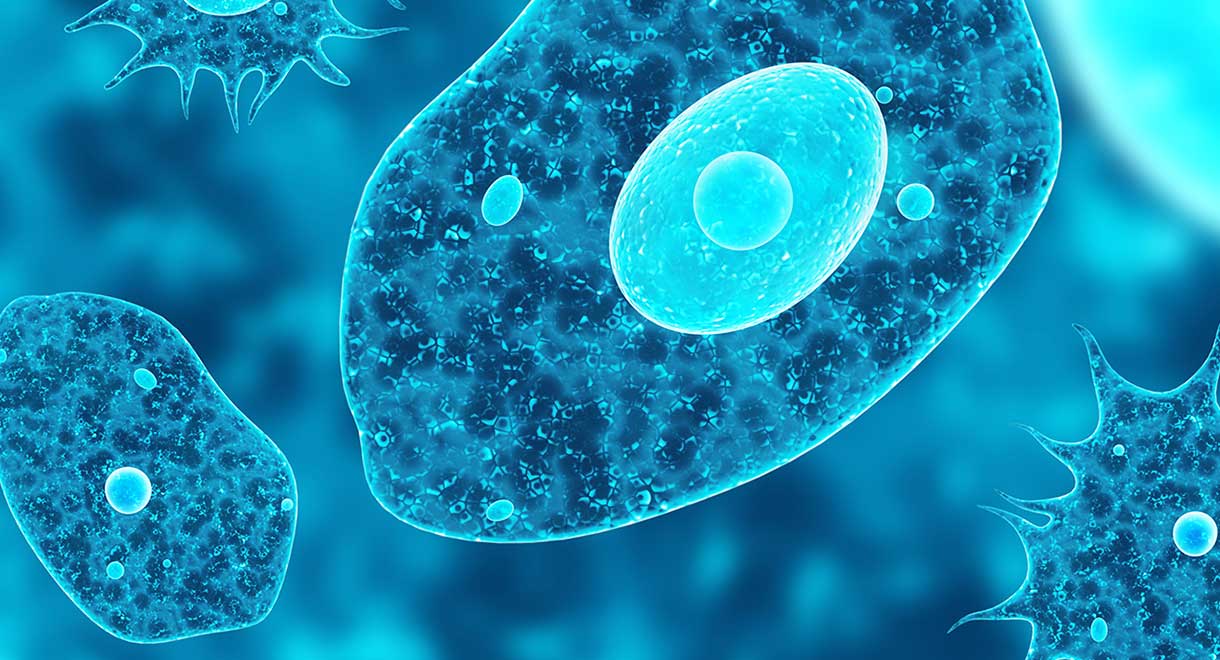
What do you do when the infestation is systemic (Larva Migrans) rather than intestinal? Because they are not intestinal, doctors won’t believe me, and won’t treat me, but I’m not an idiot. I know what I feel. The damn things are everywhere! I’ve tried all the usual remedies with no success. All they do is send the beasts into breeding & hatching mode! I just can’t win.
Hi Ali,
Larva migrans is produced when hookworm larvae invade the upper layers of skin.
It is usually a self-limiting infestation when larvae die at about 6 weeks.
If you are being reinfected then Albendazole or Ivermectin are indicated as anti-parasitics, even though Ivermectin is not accredited for this infestation.
BactoClear 2 capsules with meals twice daily to help kill the parasites, and NAC taken 2 capsules twice daily with lots of water to raise the body’s glutathione level to remove them and Magnesium Ultrapotent 1 tsp twice daily to reduce irritation caused by the movement of the larvae. Fish Oil may help to reduce the inflammatory response of the body to the parasites.
Kind regards,
Victoria Taylor
victoriat@cabothealth.com.au
Hello. Thank you for this informative article. I have recently been diagnosed with Aeromonus infection with a stool sample test. It is prooving most debilitating, long lasting and difficult to treat. I not keen to take the recommended anitbiotic because of it’s possible side effects. I am taking Bactclear and probiotics. What ekse can I do?
Hi Barbara,
There are a number of Aeromonas species and they seem to have a considerable ability to develop resistance to many antibiotics.
As well as Bacto Clear we strongly recommend you obtain some Berberine and Ox Bile from Liverdoctor.com in USA. (Use Take20 as a promocode for discount).
Which antibiotic were you recommended, because it may be easier to heal your liver once the offending bacteria has gone.
Kind regards
Victoria Taylor
Naturopath for Dr Cabot MD
I have pancreatitis and all my upper organs came back positive on the ultra sound. No issues with the gallbladder or gallstones. Can a parasites infection cause pancreatitis?
Hi Gillian,
I believe Margaret responded to your email about this.
Kind regards,
Jessah Shaw
Nutritionist